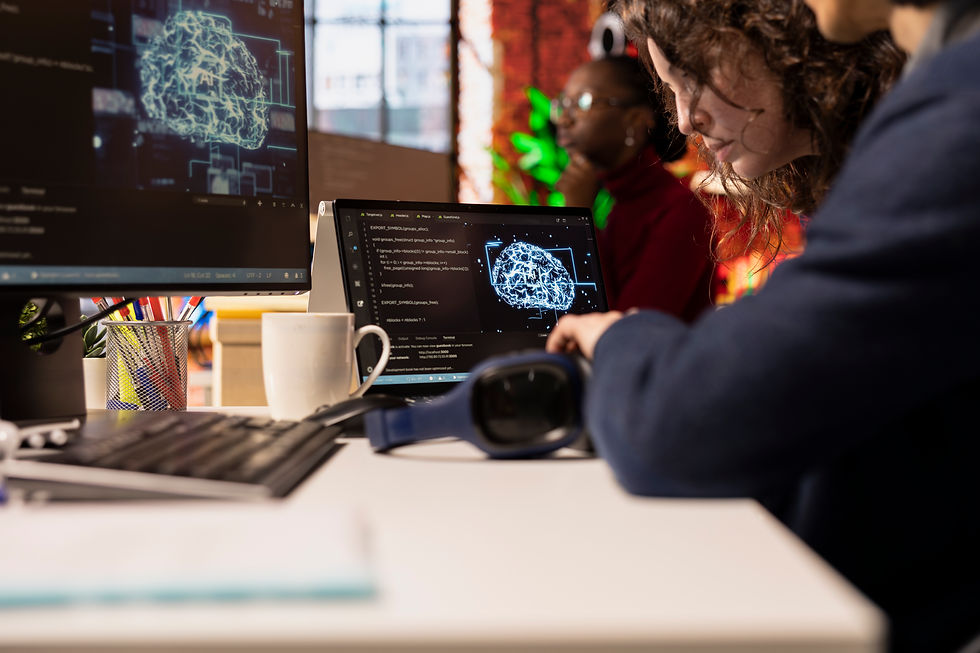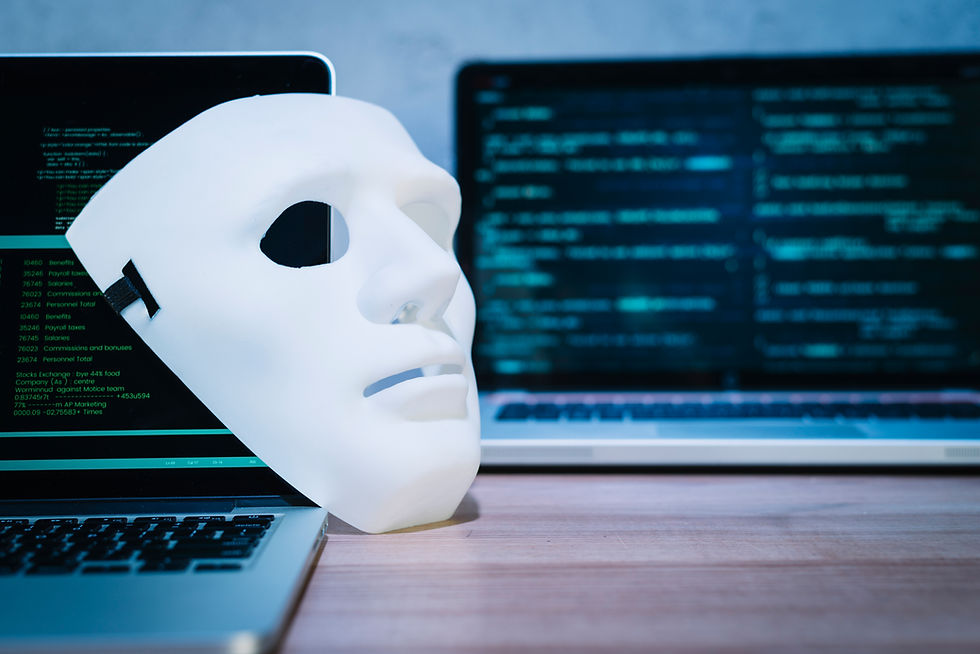AI in Cybersecurity: How Artificial Intelligence is Changing the Game
- Manisha Chaudhary
- Aug 16
- 8 min read

Introduction: AI in Cybersecurity
The digital world is constantly threatened by hackers, malware, and data breaches. Artificial Intelligence (AI) has become a vital tool to combat these evolving risks. AI in cybersecurity is not just a trend but a revolution, enabling smarter, faster, and more proactive defense mechanisms. By 2025, AI will redefine how organizations secure their networks, applications, and data.
Role of Artificial Intelligence AI in Cybersecurity as Modern Solutions
Artificial Intelligence plays a critical role in strengthening modern cybersecurity solutions by bringing automation, accuracy, and adaptability to defense strategies. Unlike traditional systems that rely on static rules, AI-powered security tools continuously learn from new data and adapt to evolving threats.
Some key roles AI plays include:
Threat Detection at Scale: AI can analyze billions of data points from logs, network traffic, and endpoints to spot anomalies that human analysts might miss.
Behavioral Analytics:
AI systems learn the normal behavior of users and devices, making it easier to detect unusual patterns such as unauthorized access or suspicious data transfers.
Automated Incident Response:
With AI, security platforms can automatically isolate infected systems, block malicious IP addresses, and neutralize attacks in real time.
Predictive Intelligence:
Machine learning algorithms forecast potential attack vectors by studying past incidents, helping organizations prepare before an attack occurs.
Adaptive Security:
AI solutions evolve with changing tactics of hackers, reducing reliance on outdated signature-based defenses.
What is the Impact of AI in Cybersecurity Industry in 2025?

By 2025, Artificial Intelligence will redefine the cybersecurity industry with smarter threat detection, automated defenses, and predictive analytics that outpace traditional methods. AI-driven systems will identify zero-day vulnerabilities within seconds, ensure compliance with global data protection laws, and integrate seamlessly with cloud, IoT, and blockchain security. The industry will also witness a surge in career opportunities, as organizations demand experts skilled in both AI and cybersecurity. With global investments rising, AI will not only reduce cyber risks but also build digital trust, making it the backbone of modern cyber defense.
Key Impacts of AI in 2025
Smarter and faster threat detection
Automated cyber defense and response
AI-driven compliance and risk management
New career opportunities in AI-cybersecurity
Integration with emerging technologies (IoT, blockchain, cloud)
How AI and Machine Learning Are Used in Cyber Threat Detection

Artificial Intelligence (AI) and Machine Learning (ML) are transforming cyber threat detection by moving beyond traditional rule-based systems and enabling smarter, adaptive defenses. Instead of relying on fixed signatures, AI and ML continuously learn from vast amounts of security data — such as network logs, user behavior, and attack patterns — to identify suspicious activity in real time.
Behavioral Analysis
AI studies normal user and device behavior. When unusual actions occur — such as multiple failed logins or suspicious data transfers — it quickly raises an alert.
Anomaly Detection
Machine learning models monitor network traffic and system activities, identifying irregular patterns that may signal malware, phishing, or insider attacks.
Predictive Threat Intelligence
By analyzing past incidents, AI predicts possible attack vectors, helping organizations strengthen weak points before hackers exploit them.
Automated Threat Response
AI-driven tools isolate infected devices, block malicious IP addresses, and neutralize attacks automatically, reducing the need for manual intervention.
Reduced False Positives
AI and ML refine detection accuracy, minimizing false alerts so security teams can focus on genuine threats.
Artificial Intelligence Applications in Cybersecurity and Data Protection

Artificial Intelligence Applications in Cybersecurity and Data Protection
AI is transforming cybersecurity and data protection through fraud detection, cloud security, endpoint protection, data privacy compliance, and phishing prevention. From blocking spam emails and detecting ransomware to monitoring cloud workloads and ensuring regulatory compliance, AI applications help organizations safeguard sensitive information with speed, accuracy, and proactive defense.
How AI is Transforming Cyber Defense Strategies

Cyber defense is evolving rapidly as cybercriminals develop more advanced attack techniques. Traditional methods are often reactive, leaving gaps in protection. Artificial Intelligence (AI) is transforming this landscape by providing proactive, intelligent, and automated defense mechanisms that adapt to ever-changing threats.
From Reactive to Proactive Security
AI allows organizations to move from simply responding to attacks to preventing them before they occur, strengthening overall resilience.
Continuous Monitoring
AI-powered systems watch over networks and endpoints around the clock, detecting anomalies and suspicious activities in real time.
Predictive Intelligence
Using historical data, AI predicts potential attack vectors and highlights vulnerabilities that need immediate attention.
Automated Incident Response
AI responds instantly to incidents by isolating compromised systems, blocking malicious IPs, and containing attacks without human delay.
Strengthening Zero Trust Models
AI enhances Zero Trust frameworks by constantly verifying users, devices, and activities, reducing the chances of unauthorized access.
Benefits of Using AI in Cybersecurity Threat Detection and Response

AI offers significant advantages in cybersecurity, including faster threat detection that identifies attacks in real time, and automated response that quickly isolates infected systems to minimize damage. It helps reduce false positives, ensuring analysts focus only on genuine risks. With scalability, AI can monitor thousands of devices and users simultaneously, while its continuous learning capability allows it to adapt to evolving cyber threats. These benefits make AI a powerful ally in modern threat detection and response.
Examples of Artificial Intelligence in Real-World Cybersecurity

Artificial Intelligence is no longer just a futuristic concept — it is actively protecting organizations and individuals from cyber threats every day. From filtering spam emails to securing sensitive healthcare data, AI is embedded into many cybersecurity solutions across industries. Below are some real-world applications where AI plays a critical role.
Email Security
AI helps block billions of spam and phishing attempts daily. For example, Gmail uses AI-powered filters to prevent over 99% of malicious emails from reaching users.
Fraud Detection in Banking
Banks use AI algorithms to analyze transaction patterns, flagging unusual activity such as unauthorized purchases or identity theft in real time.
Healthcare Data Protection
Hospitals and medical institutions apply AI-driven systems to secure patient records, safeguard IoT-enabled medical devices, and stop ransomware attacks.
Enterprise Network Security
Corporates implement AI-powered intrusion detection systems and firewalls that continuously monitor traffic, detect anomalies, and block suspicious activities automatically.
Cloud Security
AI strengthens cloud defense by identifying misconfigurations, monitoring data flows, and ensuring compliance with privacy regulations like GDPR and DPDP.
Craw Security AI in Cybersecurity Training Institute in Delhi

Craw Security, based in Delhi’s Saket and Laxmi Nagar, is at the forefront of AI-integrated cybersecurity education. Their courses combine hands-on learning with cutting-edge AI tools, helping learners build real-world expertise in threat detection, ethical hacking, and endpoint protection.
AI-Powered 6-Month & 1-Year Diplomas
Craw Security offers a 6-month diploma in Information Security powered by AI, covering fundamentals like ethical hacking, malware analysis, and digital forensics, complemented by hands-on labs and job placement assistance.Craw Security also provide a 1-year AI-enabled Cybersecurity Diploma that embeds AI across the curriculum to elevate practical skills and output.
AI-Enhanced Ethical Hacking & Endpoint Security
Their Ethical Hacking course with AI integrates machine learning and intelligent automation within the syllabus, ensuring students learn the latest defense mechanisms. For endpoint defense, the Endpoint Security course includes AI-powered tools and modules like Security Information and Event Management (SIEM), EDR/XDR systems, and AI-fortified firewalls.Craw Security
Advanced AI Training Modules
Craw Security also offers a standalone Artificial Intelligence course boasting a 10-module curriculum, encompassing neural networks, deep learning, NLP, computer vision, and more. This AI track enhances students’ understanding of AI applications in cybersecurity and beyond.
Expert Trainers & Placement Support
The institute is backed by seasoned cybersecurity professionals, offering practical, instructor-led training that is highly rated by students. Their programs regularly include placement support such as resume building and mock interviews to help learners secure roles post-training.
Future of Artificial Intelligence in Cybersecurity (2025)

By 2025, AI has become a central force in cybersecurity, helping organizations move from reactive defenses to proactive, predictive security models. Real-world examples across banking, healthcare, and enterprise IT show how AI is shaping the way we protect sensitive data and digital assets.
Autonomous Cyber Defense
AI-driven platforms like Darktrace’s Cyber AI Analyst automatically investigate incidents, reducing investigation time by up to 92%. This allows security teams to respond to threats almost instantly without human delay.
Predictive Threat Detection
Companies like CrowdStrike use AI-powered machine learning models to identify zero-day exploits before attackers can weaponize them. In 2025, this predictive capability helps enterprises stop attacks at the reconnaissance phase.
Fraud Detection in Finance
Banks such as HSBC and JPMorgan Chase deploy AI systems that monitor millions of transactions in real time. These models flag anomalies and block fraudulent payments instantly, safeguarding customer assets.
Cloud & Zero Trust Security
Microsoft Defender for Cloud integrates AI to detect suspicious workloads, misconfigurations, and insider threats. Combined with Zero Trust policies, it ensures only verified users and devices can access sensitive resources.
AI in Combating Deepfakes
In India, Vastav AI was launched to identify and mitigate deepfake threats, helping businesses, media houses, and law enforcement authenticate digital content and prevent misinformation attacks.
AI-Enhanced Healthcare Security
Hospitals worldwide now rely on AI to detect ransomware. For example, Mayo Clinic uses AI to monitor abnormal patterns in medical IoT devices, ensuring patient safety and protecting electronic health records.
Human + AI Collaboration
At IBM Security, AI systems analyze billions of security events daily. Human analysts then use these insights to focus on complex investigations, creating a strong human-AI partnership.
Frequently Asked Question (FAQs)
Q1. What is the role of AI in modern cybersecurity solutions?
AI helps in real-time threat detection, automated response, and predictive analysis for stronger security.
Q2. What is the impact of AI on cybersecurity industry in 2025?
AI will make cybersecurity faster, smarter, and more job-oriented, with increased use in defense and compliance.
Q3. How are AI and machine learning used in cyber threat detection?
They detect abnormal behaviors, predict attack vectors, and provide real-time alerts.
Q4. What are artificial intelligence applications in cybersecurity and data protection?Applications include fraud detection, cloud security, endpoint protection, and compliance monitoring.
Q5. How is AI transforming cyber defense strategies?
By shifting from reactive responses to proactive prevention with continuous monitoring.
Q6. What are the benefits of AI in cybersecurity threat detection and response?
AI offers speed, accuracy, scalability, automation, and adaptive learning.
Q7. Can you give examples of AI in real-world cybersecurity?
Yes, Gmail spam filters, banking fraud detection, and AI-powered enterprise firewalls.
Q8. Where can I learn AI in cybersecurity in Delhi?
Craw Security is a top institute offering AI in cybersecurity training with placement support.
Q9. What is the future of artificial intelligence in cybersecurity 2025?
AI will evolve into autonomous defense systems and create new career opportunities.
Q10. Can AI replace human cybersecurity professionals?
AI enhances security but cannot replace human judgment. Human-AI collaboration is essential.
Conclusion
Artificial Intelligence is transforming cybersecurity into a smarter, faster, and more proactive defense system. By 2025, AI will no longer be just a supporting tool but the backbone of modern cyber defense — strengthening detection, automating responses, and predicting threats before they strike. From protecting sensitive healthcare data and preventing financial fraud to enhancing enterprise networks and securing the cloud, AI is shaping the future of digital security across industries.
However, while AI brings powerful advantages, it cannot replace human expertise. The future lies in collaboration, where AI handles large-scale analysis and automated defenses, while cybersecurity professionals apply critical thinking and strategic decision-making. Together, human intelligence and AI will build a resilient cyber landscape, ensuring trust, safety, and security in the digital age. WhatsApp now for more information.




Comments